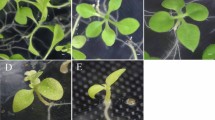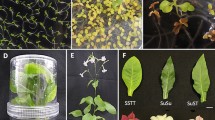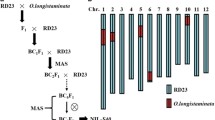Abstract
Hybrid seedlings from the cross Nicotiana tabacum × N. suaveolens express lethality at 28°C. We carried out a cross between monosomic lines of N. tabacum lacking the Q chromosome and N. suaveolens by test-tube pollination and ovule culture at 28°C. To suppress hybrid lethality, hybrid seedlings obtained were transferred to 36°C immediately after germination and cultured. We determined whether Q-chromosome-specific DNA markers were detected among hybrid seedlings. When hybrid seedlings cultured at 36°C were transferred to 28°C, hybrid seedlings in which Q-chromosome-specific DNA markers were detected expressed hybrid lethality, while hybrid seedlings in which Q-chromosome-specific DNA markers were not detected did not express hybrid lethality. From these results, we concluded that the presence of the Q chromosome of N. tabacum is related to hybrid lethality observed in crosses between N. tabacum and N. suaveolens. This is the first report that clearly demonstrates the relationship between a certain chromosome and hybrid lethality in the genus Nicotiana using chromosome-specific DNA markers. Additionally, we confirmed that the Q chromosome belongs to the S subgenome because Q-chromosome-specific DNA markers were detected only in N. sylvestris.





Similar content being viewed by others
References
Cameron DR (1959) The monosomics of Nicotiana tabacum. Tob Sci 3:164-166
Christoff M (1928) Cytological studies in the genus Nicotiana. Genetics 13:233–277
Clausen RE, Cameron DR (1944) Inheritance in Nicotiana tabacum. XVIII. Monosomic analysis. Genetics 29:447–477
Gerstel DU, Burns JA, Burk LG (1979) Interspecific hybridizations with an African tobacco, Nicotiana africana Merxm. J Hered 70:342–344
Gray JC, Kung SD, Wildman SG, Sheen SJ (1974) Origin of Nicotiana tabacum L. detected by polypeptide composition of Fraction I protein. Nature 252:226–227
Hermsen JGTh (1963) Hybrid necrosis as a problem for the wheat breeder. Euphytica 12:1–16
Hollingshead L (1930) A lethal factor in Crepis effective only in an interspecific hybrid. Genetics 15:114–140
Inoue E, Marubashi W, Niwa M (1996) Genomic factors controlling the lethality exhibited in the hybrid between Nicotiana suaveolens Lehm. and N. tabacum L. Theor Appl Genet 93:341–347
Inoue E, Marubashi W, Niwa M (2000) Characterization and overcoming of temperature-dependent lethality exhibited by hybrid embryos from the cross Nicotiana suaveolens × N. sylvestris. Breed Sci 50:297–302
Kobori S, Marubashi W (2004) Programmed cell death detected in interspecific hybrids of Nicotiana repanda × N. tomentosiformis expressing hybrid lethality. Breed Sci 54:347–350
Kostoff D (1930) Ontogeny, genetics, and cytology of Nicotiana hybrids. Genetica 12:33–139
Lee JA (1981) Genetics of D3 complementary lethality in Gossypium hirsutum and G. barbadense. J Hered 72:299–300
Lim KY, Matyášek R, Lichtenstein CP, Leitch AR (2000) Molecular cytogenetic analyses and phylogenetic studies in the Nicotiana section Tomentosae. Chromosoma 109:245–258
Marubashi W, Onosato K (2002) Q chromosome controls the lethality of interspecific hybrids between Nicotiana tabacum and N.suaveolens. Breed Sci 52:137–142
Murad L, Lim KY, Christopodulou V, Matyasek R, Lichtenstein CP, Kovarik A, Leitch AR (2002) The origin of tobacco’s T genome is traced to a particular lineage within Nicotiana tomentosiformis (Solanaceae). Am J Bot 89:921–928
Murashige T, Skoog F (1962) A revised medium for rapid growth and bio assays with tobacco tissue cultures. Physiol Plant 15:473–497
Murray MG, Thompson WF (1980) Rapid isolation of high molecular weight plant DNA. Nucleic Acids Res 8:4321–4325
Oka H (1957) Phylogenetic differentiation of cultivated rice. XV. Complementary lethal genes in rice. Jpn J Genet 32:83–87
Olmo HP (1935) Genetical studies of monosomic types of Nicotiana tabacum. Genetics 20:286–300
Sawant AC (1956) Semilethal complementary factors in a tomato species hybrid. Evolution 10:93–96
Sheen SJ (1972) Isozymic evidence bearing on the origin of Nicotiana tabacum L. Evolution 26:143–154
Shii CT, Mok MC, Temple SR, Mok DWS (1980) Expression of developmental abnormalities in hybrids of Phaseolus vulgaris L. Interaction between temperature and allelic dosage. J Hered 71:218–222
Stebbins GL (1966) Reproductive isolation and the origin of species. In: Processes of organic evolution. Prentice-Hall, New Jersey, pp 85–112
Takahashi R, Hayashi J, Moriya I (1970) Studies on lethal seedlings of barley by complementary genes. I. Mode of inheritance and the geographical distribution of the lethal genes. Nogaku Kenkyu 53:197–204
Tezuka T, Marubashi W (2004) Apoptotic cell death observed during the expression of hybrid lethality in interspecific hybrids between Nicotiana tabacum and N. suaveolens. Breed Sci 54:59–66
Tezuka T, Onosato K, Hijishita S, Marubashi W (2004) Development of Q-chromosome-specific DNA markers in tobacco and their use for identification of a tobacco monosomic line. Plant Cell Physiol 45:1863–1869
Yamada T, Marubashi W, Niwa M (2000) Apoptotic cell death induces temperature-sensitive lethality in hybrid seedlings and calli derived from the cross of Nicotiana suaveolens × N. tabacum. Planta 211:614–622
Yang D, Naito Y, Ishikawa M, Kojima T, Tazuke A, Niwa M (2001) Abundant DNA markers detected by PCR using simple sequence repeat primers without anchor sequences in soybean. Breed Sci 51:207–210
Acknowledgments
We thank Dr. G. Kokubugata (Tsukuba Botanical Garden, National Science Museum, Japan) for helpful discussions. This work was partly supported by Grant-in-Aid for Scientific Research (A) no. 13306003 and (C) no. 15580003 from the Ministry of Education, Culture, Sports, Science and Technology, Japan.
Author information
Authors and Affiliations
Corresponding author
Additional information
Communicated by J. S. Heslop-Harrison
Rights and permissions
About this article
Cite this article
Tezuka, T., Marubashi, W. Hybrid lethality in interspecific hybrids between Nicotiana tabacum and N. suaveolens: evidence that the Q chromosome causes hybrid lethality based on Q-chromosome-specific DNA markers. Theor Appl Genet 112, 1172–1178 (2006). https://doi.org/10.1007/s00122-006-0219-0
Received:
Accepted:
Published:
Issue Date:
DOI: https://doi.org/10.1007/s00122-006-0219-0




